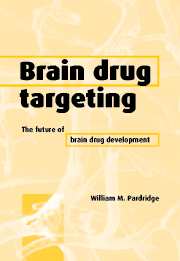Book contents
- Frontmatter
- Contents
- Preface
- List of abbreviations
- 1 Drug targeting, drug discovery, and brain drug development
- 2 Invasive brain drug delivery
- 3 Lipid-mediated transport and carrier-mediated transport of small molecules
- 4 Receptor-mediated transcytosis of peptides
- 5 Vector discovery: genetically engineered Trojan horses for drug targeting
- 6 Linker strategies: the engineering of multifunctional drug formulations
- 7 Protein neurotherapeutics and peptide radiopharmaceuticals
- 8 Antisense neurotherapeutics and imaging gene expression in vivo
- 9 Gene therapy of the brain
- 10 Blood–brain barrier genomics
- References
- Index
- Plate section
7 - Protein neurotherapeutics and peptide radiopharmaceuticals
Published online by Cambridge University Press: 08 January 2010
- Frontmatter
- Contents
- Preface
- List of abbreviations
- 1 Drug targeting, drug discovery, and brain drug development
- 2 Invasive brain drug delivery
- 3 Lipid-mediated transport and carrier-mediated transport of small molecules
- 4 Receptor-mediated transcytosis of peptides
- 5 Vector discovery: genetically engineered Trojan horses for drug targeting
- 6 Linker strategies: the engineering of multifunctional drug formulations
- 7 Protein neurotherapeutics and peptide radiopharmaceuticals
- 8 Antisense neurotherapeutics and imaging gene expression in vivo
- 9 Gene therapy of the brain
- 10 Blood–brain barrier genomics
- References
- Index
- Plate section
Summary
Introduction
The human brain uses less than a dozen monoaminergic or aminoacidergic neurotransmitter systems, but employs hundreds of peptidergic neurotransmission and neuromodulation systems. Therefore, targeting neuropeptide receptor systems in the brain offers numerous opportunities for the development of novel neurotherapeutics and neurodiagnostics for the treatment and diagnosis of brain diseases (Pardridge, 1991). One approach to the development of peptide-based neuropharmaceuticals is the discovery of small molecule peptidomimetics. However, there are two problems with small molecule drug development. First, small molecule peptidomimetic drugs, should they be discovered, tend to be peptide receptor antagonists, not agonists (Hefti, 1997). When the endogenous ligand is more than 10 amino acids in length, there are few, if any, examples of pharmacologically active small molecule peptidomimetics in clinical practice. The second problem is that, even if a small molecule peptidomimetic drug was discovered, the molecule would still need a blood–brain barrier (BBB) drug-targeting system if the molecule did not have the dual molecular characteristics of (a) lipid-solubility, and (b) molecular weight under a threshold of 400–600 Da (Chapter 3).
Given the problems inherent in the drug discovery of functional small molecule peptidomimetics, and given the abundance of known endogenous neuropeptides that are biochemically characterized, one could ask why there is not a single neuropeptide presently in clinical practice as either a neurotherapeutic or neurodiagnostic agent for the central nervous system (CNS)? Neuropeptides have not been developed as neuropharmaceuticals because, with few exceptions, neuropeptides do not cross the BBB in pharmacologically significant amounts.
- Type
- Chapter
- Information
- Brain Drug TargetingThe Future of Brain Drug Development, pp. 186 - 220Publisher: Cambridge University PressPrint publication year: 2001



